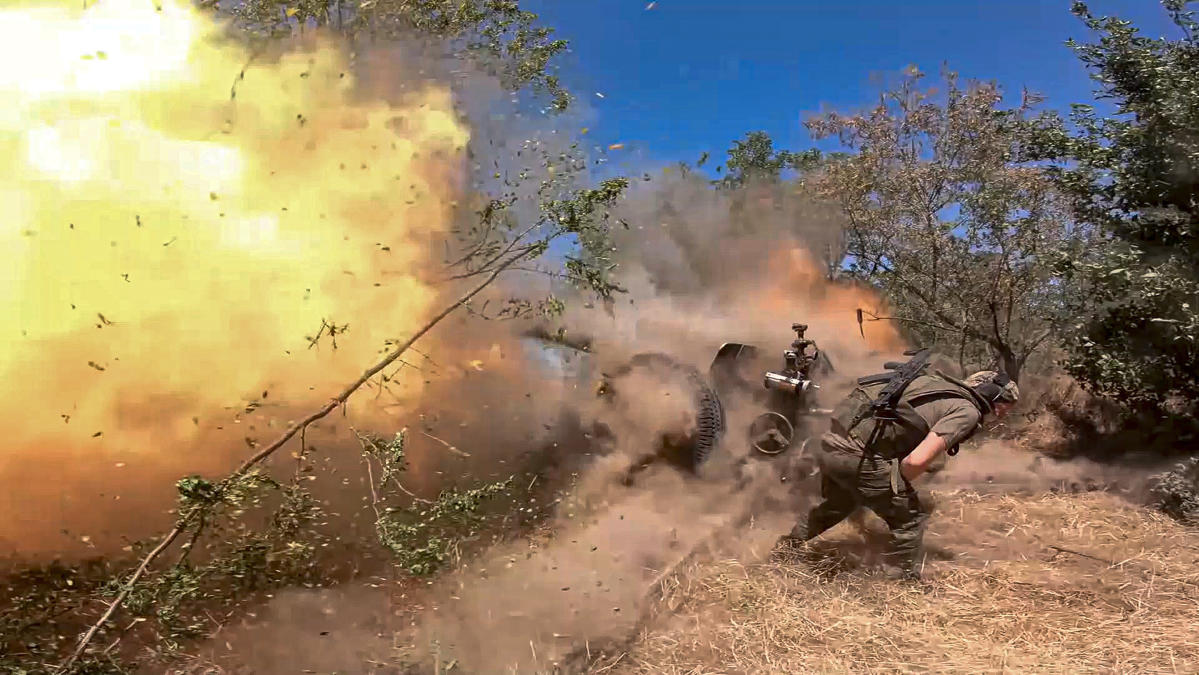
KYIV, Ukraine (AP) — Ukraine’s military says it used high-precision glide bombs provided by the United States to carry out strikes in Russia’s Kursk region while also claiming to have recaptured some territory in the eastern region of Kharkiv, where Russia launched an offensive in the spring.
Ukraine’s Air Force Commander Lt. Gen. Mykola Oleschuk issued a video Thursday night purporting to show a Russian platoon base being hit in the Kursk region. He said the attack with GBU-39 bombs resulted in Russian casualties and the destruction of equipment.
The video showed multiple explosions and plumes of smoke rising at the site.
Separately, Ukraine’s 3rd Separate Assault Brigade said its forces advanced nearly two square kilometers (about three-quarters of a square mile) in the Kharkiv region. Details were not divulged about the timing, scale, and area of the offensive, and it’s hard to predict if it will have any more impact on the battlefield.
Ukraine’s forces have gained new momentum this month after delayed deliveries of U.S. weaponry were finally released. Kyiv launched a shock offensive into Russia’s western Kursk region on August 6, while simultaneously intensifying a drone war against military and fuel targets that sparked blazes deep in Russia this week.
On Friday some new details emerged about damage and injuries caused by some of those attacks.
A Ukrainian drone attack targeting a distant Russian air base in its Volgograd region caused significant damage to an airfield that reportedly housed glide bombs used by Moscow in the war, satellite photos analyzed Friday by The Associated Press showed.
Meanwhile, an attack on a cargo ferry at the port of Kavkaz in Russia’s Krasnodar region on Thursday injured 13 people, Russia’s state news agency Tass reported Friday. Citing health officials, Tass said that four of the injured have been hospitalized and one other person remained unaccounted for.
Ukraine’s gains have reshaped the battlefield and buoyed the morale of Ukrainians 10 years after Russia first invaded their country, and 2 1/2 years after Moscow launched a full-scale invasion that has led to mass death and destruction and created Europe’s largest refugee crisis since World War II.
Ukraine and its Western allies hope that the regained momentum could strengthen Kyiv’s hand on the diplomatic front.
A visit to Kyiv by Indian Prime Minister Narendra Modi, who is meeting Friday with President Volodymyr Zelenskyy, is being closely watched. There are Ukrainian hopes that Modi, who has maintained cordial ties and economic relations with Russian President Vladimir Putin, could play a role in forging a mediated peace.
The incursion into Russia has highlighted Russian vulnerabilities but also further stretched Ukrainian forces, who were already fighting on a frontline running hundreds of kilometers (miles). It has possibly compromised Ukraine’s ability to hold back Russian forces who have slowly but steadily gained ground in the Donetsk region, diverting Ukrainian forces who otherwise could bolster defense there.
It’s not clear how long Ukraine will be able to hold the land it has seized in Russia.
The Russian Defense Ministry on Friday said that its troops turned back Ukrainian attempts to advance on the Kursk region’s villages of Borki and Malaya Loknya. The ministry also reported taking out a reconnaissance and sabotage group near Kamyshevka, 20 kilometers (12 miles) north of Sudzha, which the Ukrainians took.
Ukraine’s 3rd Separate Assault Brigade said in a statement published late Thursday that Ukrainian soldiers took control of an area that was held by a Russian battalion, and some strongholds.
Brigade Commander Andrii Biletskyi said that they attacked Russian troops that had superiority “and won,” adding that the ratio of forces on the battlefield was 2.5:1 in Moscow’s favor.
The Associated Press was unable to independently verify the claims, and there was no immediate comment from Russia.
Russia launched an offensive in the Kharkiv region in May that led to some gains but soon stalled. Fighting in that area has diminished as the Russian army has concentrated its efforts in Donetsk, part of the industrial Donbas region that Moscow formally annexed but does not fully control.
Russia’s springtime advance on Kharkiv was seen as a sign that Ukraine’s position was weakening amid the delays of Western military aid.
___
Gera contributed from Warsaw, Poland. Associated Press writer Jon Gambrell in Dubai, United Arab Emirates, contributed.
EMEA Tribune is not involved in this news article, it is taken from our partners and or from the News Agencies. Copyright and Credit go to the News Agencies, email news@emeatribune.com Follow our WhatsApp verified Channel





